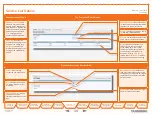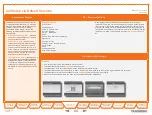
D13841.08
10.2007
32
TANDBERG
3G Gateway
USER GUIDE
TANDBERG
3G GATEWAY
USER GUIDE
Select
SS7
to access the
SS7
Configuration
pane.
General
Originating Point Code (OPC)
•
.
A number in
the range 0–2
14
, which uniquely identifies a
signalling point, in this case the 3G Gateway,
within a telephone network. This number
consists of three parts, viz. a network,
cluster and member number, and will be
provided by the network operator.
Network indicator
•
.
A two bit data field
within the Service Information Octet of
the Message Signal Unit that permits
discrimination between national and
international messages.
Audio Codec / Law
•
.
Either ALAW or ULAW. An
a-law algorithm is a standard companding, i.e.
compressing and expanding, algorithm, used
in European digital communication systems
to optimize, i.e. modify, the dynamic range
of an analogue signal for digitizing. The µ-law
algorithm is similar to a-law and used in North
American and Japanese systems.
SS7 Configuration
Trunks
A maximum of four PRIs or SS7 trunks, i.e.
cables carrying E1/T1, can be enabled in the 3G
Gateway.
Mode
•
. Enable or disable a trunk.
Destination Point Code (DPC)
•
. Uniquely
identifies the destination signalling point of
the trunk. It will be provided by the network
operator.
CIC
•
.
The Circuit Identification Code is a
unique identifier for a data time slot in
a cable (trunk). In this case the CIC acts
as base address and can be defined for
each SS7 trunk and sets the first time-slot
number of the respective SS7 trunk.
Link Set Details
A link is a time slot within a trunk
used for signalling. Link sets are
typically used for signalling fail-over
purposes to one switch.
Enabled
•
.
Checking this box ena-
bles at least one signalling link in
a link set.
Destination Point Code
•
.
Uniquely
identifies the destination signal-
ling point of the link. This can dif-
fer from the DPC of the trunk, e.g.
the DPC of a Signalling Transfer
Point (STP), see example 2 on the
following pages.
Enabled
•
.
Link1 is checked by
default. Whereas, a second link
box can be checked to define
an extra signalling link for fail-
over purposes.
Trunk
•
.
Number of the trunk
(1–4) in which a time slot is
reserved for signalling.
Time slot
•
.
Number of the time
slot, within aforementioned
trunk, reserved for signalling.
SLC
•
.
A Signalling Link Code is a
unique link number provided by
the network operator to identify
a link.
To provide a better understanding
of the settings discussed here, two
examples are given on the following
pages.
Routes
Routes are typically used for signalling fail-over
purposes via multiple switches.
Destination Point Code.
•
Unique identifier
indicating the destination signalling point of
a trunk.
Priority.
•
Priority level of the route to the
destination signalling point. Fail-over signalling
paths will be followed according to this priority.
Link set.
•
Indicates the link to the destination
signalling point according to the above
mentioned priority setting. When set to off
the respective route is disabled.
















































